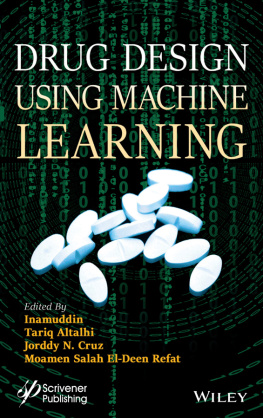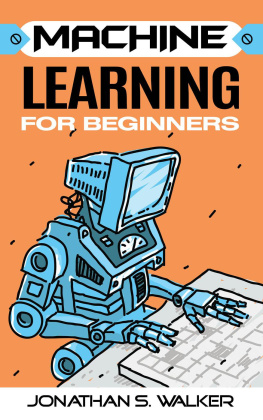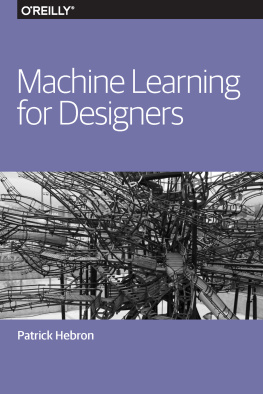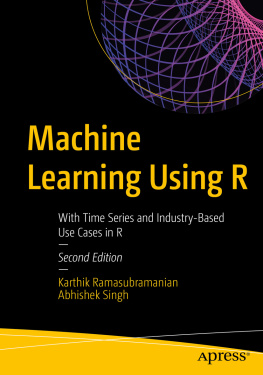Inamuddin - Drug Design Using Machine Learning
Here you can read online Inamuddin - Drug Design Using Machine Learning full text of the book (entire story) in english for free. Download pdf and epub, get meaning, cover and reviews about this ebook. year: 2022, publisher: John Wiley & Sons, Incorporated, genre: Romance novel. Description of the work, (preface) as well as reviews are available. Best literature library LitArk.com created for fans of good reading and offers a wide selection of genres:
Romance novel
Science fiction
Adventure
Detective
Science
History
Home and family
Prose
Art
Politics
Computer
Non-fiction
Religion
Business
Children
Humor
Choose a favorite category and find really read worthwhile books. Enjoy immersion in the world of imagination, feel the emotions of the characters or learn something new for yourself, make an fascinating discovery.
- Book:Drug Design Using Machine Learning
- Author:
- Publisher:John Wiley & Sons, Incorporated
- Genre:
- Year:2022
- Rating:3 / 5
- Favourites:Add to favourites
- Your mark:
- 60
- 1
- 2
- 3
- 4
- 5
Drug Design Using Machine Learning: summary, description and annotation
We offer to read an annotation, description, summary or preface (depends on what the author of the book "Drug Design Using Machine Learning" wrote himself). If you haven't found the necessary information about the book — write in the comments, we will try to find it.
Inamuddin: author's other books
Who wrote Drug Design Using Machine Learning? Find out the surname, the name of the author of the book and a list of all author's works by series.
Drug Design Using Machine Learning — read online for free the complete book (whole text) full work
Below is the text of the book, divided by pages. System saving the place of the last page read, allows you to conveniently read the book "Drug Design Using Machine Learning" online for free, without having to search again every time where you left off. Put a bookmark, and you can go to the page where you finished reading at any time.
Font size:
Interval:
Bookmark:

Scrivener Publishing
100 Cummings Center, Suite 541J
Beverly, MA 01915-6106
Publishers at Scrivener
Martin Scrivener ()
Phillip Carmical ()
Edited by
Inamuddin
Tariq Altalhi
Jorddy N. Cruz
and
Moamen Salah El-Deen Refat

This edition first published 2022 by John Wiley & Sons, Inc., 111 River Street, Hoboken, NJ 07030, USA and Scrivener Publishing LLC, 100 Cummings Center, Suite 541J, Beverly, MA 01915, USA
2022 Scrivener Publishing LLC
For more information about Scrivener publications please visit www.scrivenerpublishing.com.
All rights reserved. No part of this publication may be reproduced, stored in a retrieval system, or transmitted, in any form or by any means, electronic, mechanical, photocopying, recording, or otherwise, except as permitted by law. Advice on how to obtain permission to reuse material from this title is available at http://www.wiley.com/go/permissions.
Wiley Global Headquarters
111 River Street, Hoboken, NJ 07030, USA
For details of our global editorial offices, customer services, and more information about Wiley products visit us at www.wiley.com.
Limit of Liability/Disclaimer of Warranty
While the publisher and authors have used their best efforts in preparing this work, they make no representations or warranties with respect to the accuracy or completeness of the contents of this work and specifically disclaim all warranties, including without limitation any implied warranties of merchantability or fitness for a particular purpose. No warranty may be created or extended by sales representatives, written sales materials, or promotional statements for this work. The fact that an organization, website, or product is referred to in this work as a citation and/or potential source of further information does not mean that the publisher and authors endorse the information or services the organization, website, or product may provide or recommendations it may make. This work is sold with the understanding that the publisher is not engaged in rendering professional services. The advice and strategies contained herein may not be suitable for your situation. You should consult with a specialist where appropriate. Neither the publisher nor authors shall be liable for any loss of profit or any other commercial damages, including but not limited to special, incidental, consequential, or other damages. Further, readers should be aware that websites listed in this work may have changed or disappeared between when this work was written and when it is read.
Library of Congress Cataloging-in-Publication Data
ISBN 9781394166282
Cover image: Pixabay.Com
Cover design by Russell Richardson
Set in size of 11pt and Minion Pro by Manila Typesetting Company, Makati, Philippines
Traditionally, the design of new drugs has been a long process that requires an investment of billions of dollars. In the last decades, molecular modeling techniques have been used in the pharmaceutical industry and large laboratories to accelerate this process in order to reduce the amount of money that needs to be invested. More recently, machine learning approaches to drug discovery have aroused great interest in the scientific community. This has occurred, among other reasons, due to advances in high-performance computing and the availability of an abundance of biological and chemical information on thousands of compounds. Through machine learning and artificial intelligence approaches, this information can be filtered quickly and at a low cost. From this, algorithms can be trained to be used in the different stages of drug design.
The objective of this book is to bring together several chapters that function as an overview of the use of machine learning and artificial intelligence applied to drug development. The initial chapters discuss drug-target interactions through machine learning for improving drug delivery, healthcare, and medical systems. Further chapters also provide topics on drug repurposing through machine learning, drug designing, and ultimately discuss drug combinations prescribed for patients with multiple or complex ailments. This book should be useful for information technology professionals, pharmaceutical industry workers, engineers, university students and faculty members, medical practitioners, researchers and laboratory workers who have a keen interest in the area of machine learning and artificial intelligence approaches applied to drug advancements. A chapter-by-chapter summary of the work reported in the 12 chapters of this book follows.
- describes the use of molecular recognition for drug development through various mathematical models. Molecular docking of the main elements is discussed in detail to consider which elements are important for obtaining a reliable prediction of protein-ligand complexes. The role of machine learning in molecular recognition models is also analyzed.
- reviews classical and machine learning-based approaches to study target-drug interactions in the field of drug discovery, from target identification to the optimization of the lead compound. In addition, a special section discusses peptide-based drugs.
- gives a brief overview of the various machine learning techniques that underpin artificial intelligence, poly-pharmacology, and drug repurposing to improve healthcare services. The way in which machine learning is used throughout the drug development process to help increase its efficacy and robustness, resulting in a significant reduction of the time and cost of bringing new drugs to market, is discussed in detail.
- elaborates on the advancements in artificial intelligence technologies along with their applications, enumerates the challenges faced by these technologies that retard their full-scale implementation, and also provides an overview of their social, legal, and economic aspects. All these are discussed for various applications such as drug delivery, healthcare, and medical systems.
- details the various machine learning approaches for drug repurposing. The network-based approach, text mining-based approach, and semantics-based approach are discussed in fair detail. Furthermore, case studies of drugs repurposed through machine learning programs are also discussed.
- summarizes the recent developments in the machine learning-mediated drug discovery process within industrial and academic contexts. More precisely, machine learning algorithms used for drug discovery, bioactivity prediction using machine learning, and application of machine learning in chemo-informatics are reviewed. Furthermore, an in-depth analysis of the challenges and suggestions are provided.
- details the basic principles underlying supercritical fluid technology and its main techniques. Furthermore, the more representative biodegradable polymers impregnated with supercritical fluid technology are described. Finally, the state of the art of supercritical fluid technology for improving drug absorption in biopolymer and the delivery processes are thoroughly reviewed.
- details the different in vivo, in vitro and in silico techniques applied to study the protein-protein interactions through the active sites. The role of the active sites of protein is also discussed. Moreover, databases and algorithms are mentioned along with their uses and advantages.
Font size:
Interval:
Bookmark:
Similar books «Drug Design Using Machine Learning»
Look at similar books to Drug Design Using Machine Learning. We have selected literature similar in name and meaning in the hope of providing readers with more options to find new, interesting, not yet read works.
Discussion, reviews of the book Drug Design Using Machine Learning and just readers' own opinions. Leave your comments, write what you think about the work, its meaning or the main characters. Specify what exactly you liked and what you didn't like, and why you think so.











